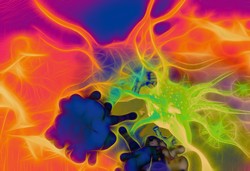Nanoscale images to diagnose disease
High-resolution imaging within cells may help clinicians to better understand how certain biological processes impact our health. Current imaging technology is, however, limited. For example, it cannot detect clumps of protein in the brain that lead to Alzheimer's disease, nor can it be used to diagnose lung cancer. To address this, scientists working on the EU-funded LANIR(opens in new window) (Label free nanoscopy using infra red) initiative developed microscopy technology that can resolve particles at a nanoscale level (down to one billionth of a metre). Infrared (IR) microscopy combines an IR spectrometer with a microscope to identify chemicals and show where they are distributed within a tissue sample. This allows researchers to view biological and chemical processes in real time with high precision and resolution. Currently, commercially available table-top IR microscopes provide at best a spatial resolution of between 50 and 100 μm. This means that the instrument can distinguish two points in space separated by approximately the width of a human hair. In a technological breakthrough, LANIR developed an IR nanoscope that has a lateral resolution of 70 nm (0.07 μm). This means it can detect two points lying side by side that are separated by the width of a typical virus particle. It can also produce 3D images at a resolution of 500 nm, which is currently not possible with IR microscopy. LANIR produced four prototype nanoscopes that are smaller, simpler to use and faster than any other commercially available imaging technology. Collaborators demonstrated that these prototypes could image nanomaterials like graphene (100 nm) and lead selenide, a semiconductor with a diameter below 100 nm. LANIR's target market will likely be materials scientists, biochemists, cell pathologists and cell biologists. However, the instruments can also be used to monitor the quality of industrial products such as antimicrobial textiles and functional coatings on biomedical implants.







